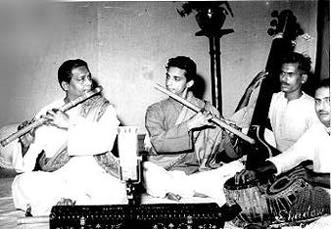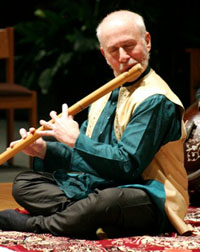|
|
Lyon Leifer HOW
TO PLAY THE BANSURI: |
|
|
Lyon Leifer HOW
TO PLAY THE BANSURI: |

A new book designed to offer a comprehensive
beginning course in the technique of the north Indian keyless
bamboo flute. Profusely illustrated with charts, exercises, photographs
of playing positions, and decorative material, the manual will
enable the student to learn authentic raga materials and methods
of development, as taught by the master flutist and flutemaker,
Shri Devendra Murdeshwar. The manual
explains fundamentals of a number of essential topics in Hindustani
music. The scalar system, the concept of raga, microtonalism,
the system of teaching and learning, and the instrument's history
are all covered.
Students of the bansuri will, of course,
find this book particularly useful. In addition, this manual will
prove helpful to all flutists seeking to broaden their viewpoint
and range of expression. Other students of Indian music may also
find its viewpoint and method for teaching the music's performance
highly useful.
Jazz musicians will find in it an especially useful compendium
of scales and scale patterns which can be put to use in various
contexts.
Chapters include information on the following subjects:
An Introduction to the bansuri.
Myth and history of the bansuri and biographical information
on prominent players and teachers.
Holding and learning to play scales.
Learning to play a raga.
Learning a composition in Raga Yemen.
The ten scales of Hindustani music along with fingerings.
Bansuris in various keys.
Producing microtones.
Appendices include a glossary of terms, bibliography, schools,
sources of instruments and recordings.
The available CD presents examples of all the major exercises and performed versions of all the compositions included here, as well as providing drone tambura and tabla accompaniment for the student's own practice. 74 pages. PG-13
About the Author
 |
Lyon Leifer is recognized in Europe, the Americas, China and India as a master flutist who performs both on western flutes and on the bansuri. After early studies in Chicago with Emil Eck and Walfrid Kujala, Mr. Leifer attended the Juilliard School of Music where he studied with Julius Baker. After graduating, he became a member of the St. Louis Symphony Orchestra. Pursuing an interest in improvised raga music and flute playing in India, he then accepted a Fulbright Grant to study there with Devendra Murdeshwar, the inheritor of the legacy of the great Pannalal Ghosh. Remaining in India for five years, Mr. Leifer won the praise of Indian audiences and critics for his authentic renditions of raga melodies.
Since returning to Chicago, Mr. Leifer has become one of the city's leading flutists and flute teachers. He gives recitals on Western flutes, both period and modern, and performs as principal flutist in Ars Viva Orchestra. He was for twenty-seven years also principal flutist of the group Music of the Baroque, where he was often featured soloist in that ensemble's concerts and syndicated broadcasts. Lyon Lieferhas won numerous awards including scholarships at Juilliard, a renewed and extended Fulbright Student Grant, a senior fellowship of the American Institute of Indian Studies, grants from the Illinois Arts Council and Chicago Artists Abroad, and the 2005-06 Fulbright Senior Research Fellowship. During his most recent Fulbright sojourn, he performed multiple recitals in Mumbai as well as performing at Kolkata, Pune, and Bhopal. Mr. Leifer has also offered master classes in venues including Shanghai, Ho Chi Minh City, Hanoi, Istanbul, Caracas, and Barbados. |
Bansuris are made and played in sizes ranging from sub-piccolo all the way to mega-alto flute equivalents. Usually, concert instruments play a tonic note (which is taken with three finger holes covered) at around D-sharp or E-natural. A flute with an E-natural tonic is a whole-step higher than an orchestral alto flute.Because the bansuri is a keyless instrument, playing a large one does require a substantial amount of practice to attain the proper grip and stretch out the hands to play with good control. Invariably, players begin on smaller, higher instruments and gradually work their way down (up?) to the concert-size.The instrument recommended for How to Play the Bansuri is pitched at a tonic of C-natural (sounding on the third space of the treble clef). This is a very conservative choice and a comfortable size for any player, even a child aged ten to twelve. Any size of bansuri may be used to work through the material of the book. However, the C-natural instrument will work best because the examples on the accompanying tape are played on this size instrument. Therefore the student with a C-natural instrument will be able to avoid a possibly disconcerting mismatch of pitch. Additionally, since some of the exercises are provided in staff notation, these will sound at pitch when played on this instrument.Six or Seven Holes?The book is based on the method developed by Pannalal Ghosh which utilizes the bansuri with seven finger holes exclusively. While a six-hole instrument can be used to play the material, the results will not be as satisfactory, due to the inherent limitations of that instrument. The seventh fingering hole enables minimally an extra half-step of range, but it also creates many more possibilities of fingerings on various notes, particularly in negotiating register breaks in both directions.
North Indian Bansuri Flute Where to purchase a Bansuri Flute Bansuri Playing Guides & Instructional Videos Recorded Music |
| Price of Book | Ordering Information |